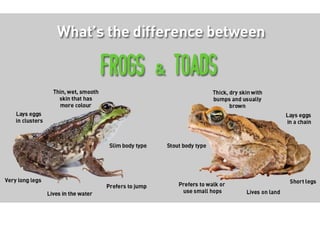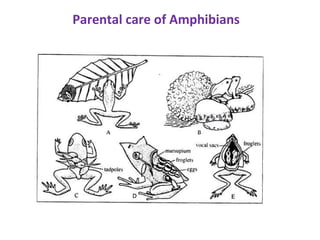Amphibia class
- 1. Class Amphibia Gr. Amphi-double and bios-life Aquatic or semi-aquatic, air and water breathing, cold-blooded, oviparous, tetrapod vertebrates Skin soft, moist and glandular. Pigment cells present Head distnict, trunk elongated. Neck and tail may be present Endoskeleton mostlybony Respiration by lungs, skin and mouth-lining. Heart 3-chambered Fertilization mostly external e.g. Bufo, Rana
- 2. Subclass 1. Stegocephalia (Extinct) Limbs pentadactyle Skin with scales and bony plates Skull with a solid bony roof leaving openings for eyes and nostrils Order 1. Labyrinthodontia Oldest known tetrapods called stem amphibia Salamander or crocodile like e.g. Eryops Order 2. Phyllospondyli Small salamander-like. Heads large, flat Vertebrae tubular Notochord and spinal cord housed in common cavity e.g. Branchiosaurs
- 3. Order 3. Lepospondyli Small salamander or eel-like Vertebrae cylindrical, each made of a single piece e.g. Diplocaulus
- 4. Subclass 2. Lissamphibia Living Modern amphibia lacking dermal bony skeleton Teeth small, simple Order 1. Gymnophiona or apoda Limbless, blind, elongated worm-like, burrowing Known as caecilians Tail short or absent, cloaca terminal Males have protrusible copulatory organ e.g. Ichthyophis
- 5. Order 2. Urodela or Caudata Lizard-like amphibians with a distnict tail Limbs 2 pairs, usually weak Skin devoid of scales and tympanum Gills permanent or lost in adult e.g. Salamandra Order 3. Salientia or anura Specialized amphibia without tail in adults Hindlimbs usually adapted for leaping and swimming Adults without gills or gill openings Eyelids well-formed. Tympanum present e.g. Bufo, Rana
- 6. Evolution of amphibians The earliest fossils of Amphibia are known as Labyrinthodonts under the subclass of Labyrinthodontia. They probably originated 300 million years ago during Devonian period and flourished through Carboniferous and Permian periods before extinction in Triassic.
- 7. Piscine ancestry: Resemblance of Amphibia to fish: Both are cold-blooded Both respire by gills early in life, in some cases throughout life Both have air-bladders serving an lungs To prevent desiccation in air, both usually lay eggs in water where larval development usually take place
- 8. Which of fish groups (Actinopterygii, Dipnoi and Crossopterygii) gave rise to the first amphibians?
- 9. Homologies between the limb bones of crossopterygians and early tetrapods Their skulls and jaws are similar and can be equated bone by bone Position of external and internal nares is similar Air bladders were used as lungs
- 12. Adaptations in amphibious life Locomotion- Streamlined body, limbs in place of paired fins Skeleton- Vertebral columns become more rigid Muscles- Stronger muscles to lift body above ground Respiration- Lungs in spite of gills, Cutaneous respiration Circulatory system Sensory system- Addition of middle ear containing a bone for transmitting sound vibrations from tympanum to inner ear.
- 13. Rana tigrina Systematic position: Habitat: Habits: Locomotion: Leaping on lands and swimming in water Feeding Croaking
- 15. External Features of frog
- 19. Digestive system of frog Alimentary canal I. Mouth II. Buccal cavity III. Pharynx IV. Oesophagus V. Stomach VI. Small intestine-Duodenum and ileum VII.Large intestine or rectum VIII.Cloaca Digestive gland i. Liver ii. Pancreas
- 20. Reproductive system of frog
- 22. Neotony The retention of a larval or embryonic trait in the adult body. e.g. the retention of embryonic cartilaginous skeleton in adult in Chondrichthyes Larval gills in some adult salamanders. This sexually mature but morphologically immature, larval stage with external gills is called axololt. Types: 3 types Partial-metamorphosis is delayed due to temporary ecological or physiological changes in environment Intermediate- axololt reproduce sexually but undergo metamorphosis in suitable conditions Extreme or total- they remain larval throughout their life e.g. Siren, Proteus Factors Abundance of food, cold temperature and insufficient iodine
- 23. Paedogenesis Development of gonads and/or production of young ones by an otherwise immature, larval or pre-adult animal
- 24. Parental care of Amphibians
- 26. Defense mechanism of amphibians Mucous secretion from their skin which make their body soft and slippery Toads have parotoid gland behind the eyes which secrete poison. When distrubed, toads frequently urinate and produce noxious unpalatable secretions from glands. Some Salamander’s skin is poisonous Some newt (Triton) discharges a sufficiently venomous secretion from its dorsal glands to ward off enemies Different coloration of frog Frog mimic other harmful species or use bright coloration to warn potential predators
- 27. Economic importance of Amphibia Scientific study As food Predation Medicinal value Trade, Art and recreation Poisonous Amphibia


























